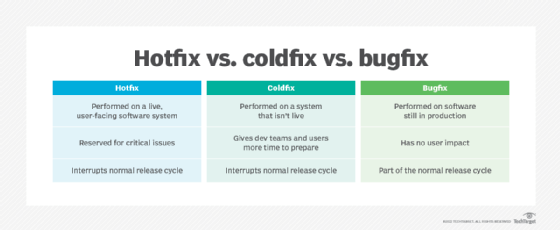hotfix
What is a hotfix?
A hotfix is code -- sometimes called a patch -- that fixes a bug in a product. Users of the product might be notified by email or obtain information about new hotfixes at a software vendor's website and download the hotfixes they wish to apply. Hotfixes are sometimes packaged as a set, called a combined hotfix package or a service pack.
Hotfixes often are implemented when software is live. However, they can also happen during software development. In that case, they interrupt a software development team's sprint or production cycle.
To prepare for a hotfix, the development team must do the following:
- gather details about the bug;
- develop a plan for addressing the bug;
- test the hotfix using test servers or sandbox environments; and
- release the hotfix to the public.
Once the hotfix is deployed, the development team returns to its sprint schedule.
Benefits of a hotfix
The following benefits often come out of the hotfix process:
- Quick, immediate fixes. Hotfixes are rolled out fast to fix bugs immediately, without waiting for the next full operating system update or release.
- High severity. A hotfix is used to rectify critical bugs that need to be fixed immediately, including those that could compromise the security or functionality of an app and cause downtime if left unfixed.
- Improved usability. When the bug is fixed, the software becomes usable again and performs better than it did previously. Users can continue to use the software without reinstalling it.
- Recoverability. Software that undergoes a hotfix can usually be rolled back to an earlier version.
Hotfix challenges
While there are several benefits to hotfixes, there are also challenges to consider:
- Interruptions. Hotfixes can disrupt the flow of the software development lifecycle.
- Rapid planning. These fixes require quick-fix engineering and planning.
- Duct taping. Organizations should not rely on hotfixes for quick, temporary fixes because short-term fixes can have a negative effect on application quality over time.
- New bugs. While hotfixes resolve critical bugs, they also can introduce new ones that result in the need for more hotfixes. The application's codebase can become saturated with hotfix code that is difficult or impossible to support long term.
Comparing hotfix, coldfix and bugfix
The terms hotfix, coldfix and bugfix all refer to program code changes, but with slightly different meanings.
Hotfix
A hotfix is an urgent measure taken to address a critical issue outside the normal DevOps workflow. These repairs are applied to a hot, or live, system. Systems are not restarted, and users do not need to uninstall or reinstall applications.
Coldfix
A coldfix is the opposite of a hotfix. To undertake a coldfix, systems are shut down, and applications are unusable while the fix is applied. Coldfixes are usually announced well in advance so that users can prepare for the time when the application will be unavailable.
Bugfix
A bugfix is a workaround to an error in programming. It is the piece of programming that corrects the bug in software. Programmers report bugfixes in software documentation when the error has been resolved.
Bugfixes are often temporary fixes to specific issues and might not deal with a larger underlying problem that's causing the bug. Unlike hotfixes, bugfixes are typically resolved in production as part of the normal release cycle. Debugging is generally only used to address critical bugs or security flaws in live, user-facing and widely accessible applications.

Hotfix example
An example of a hotfix is an e-commerce application with a vulnerability that lets unauthorized individuals access sensitive user data such as passwords and credit card numbers. The development team prioritizes fixing this vulnerability to ensure the application is not disrupted and user data remains safe.
The free, open source version control system Git has a hotfix extension called git-flow-hotfix that can help address issues in software on Git.
Examples of coldfixes and bugfixes
An example of a coldfix is when a popular online role-playing game announces it will perform maintenance on the game's back end in the next 48 hours. During that time, the game can't be used.
An example of a bugfix is when a development team notices that an e-commerce application in the testing phase has a vulnerability that would expose user data to unauthorized users. The team develops a software patch for the bug and implements the fix.
Software bugs commonly arise out of application migration. When developers move their application to the cloud, it's tempting to minimize testing and quality assurance because the process seems easy. However, this isn't always the case. Learn why cloud performance testing is required for app migration if developers want to avoid needing a hotfix down the road.








